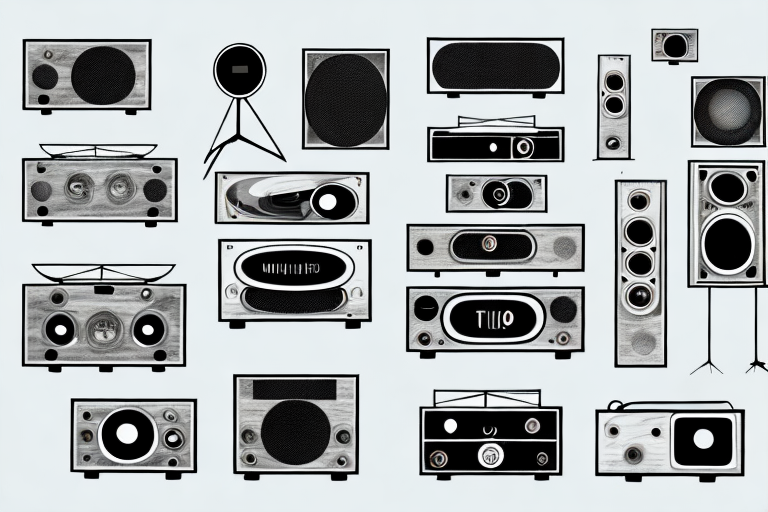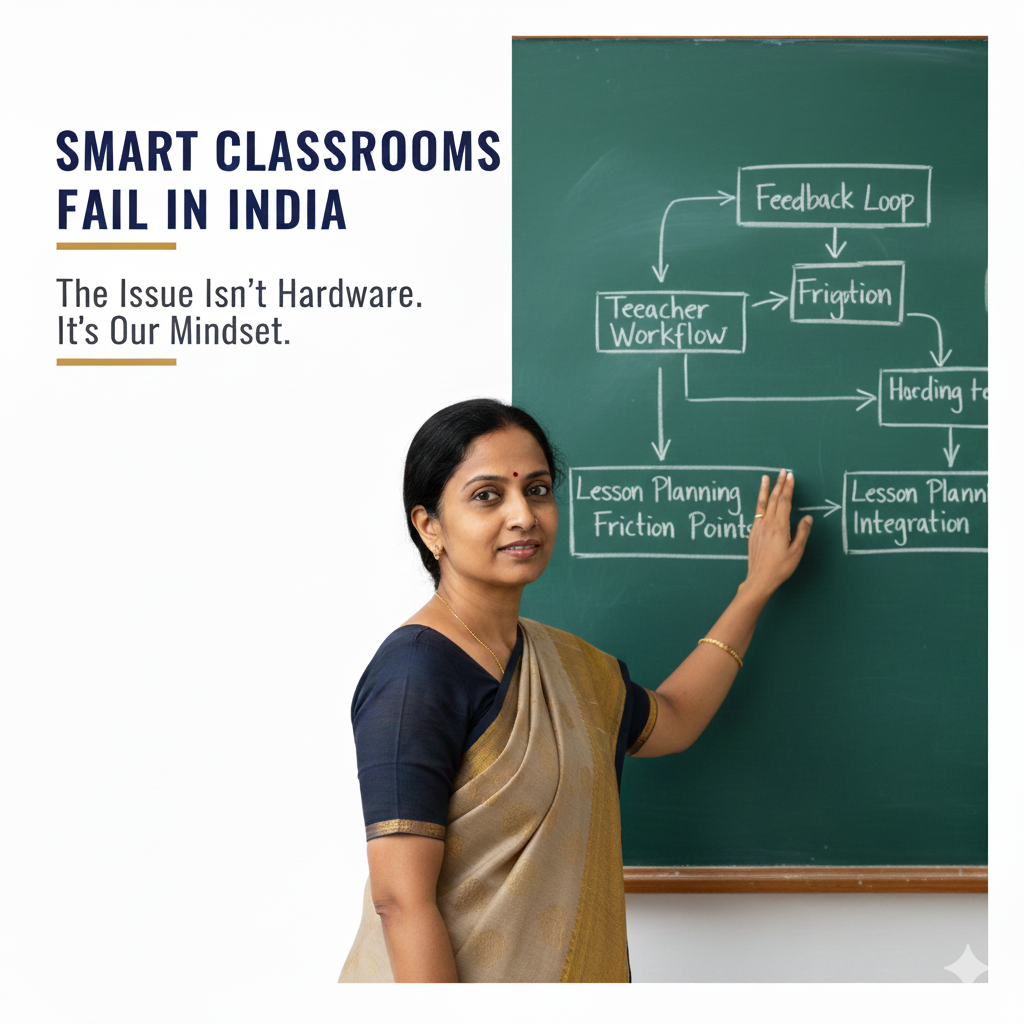The Evolution of Audio-Visual Technology: A Comprehensive Guide

In today's modern world, audio-visual technology has become an integral part of our daily lives. It has revolutionized the way we consume and interact with media, providing us with a multi-sensory experience that was once unimaginable. From the early days of sound and image reproduction to the digital age and beyond, the evolution of audio-visual technology has been a fascinating journey.
In this comprehensive guide, we will explore the different aspects of audio-visual technology, its history, and its future.
Understanding Audio-Visual Technology
Before delving into the depths of audio-visual technology, let us first understand what exactly it encompasses and why it is so important. Audio-visual technology refers to the combination of sound and visual elements to create a multimedia experience.
Whether it's watching a movie, attending a presentation, or listening to music, audio-visual technology plays a crucial role in enhancing our perception and understanding of the content.
Audio-visual technology has come a long way since its inception. From the early days of silent films to the advanced digital systems of today, it has continuously evolved to provide us with more immersive and engaging experiences. The integration of audio and visual elements allows us to not only see and hear but also feel and experience the content on a deeper level.
When it comes to movies, audio-visual technology is the backbone of the entire cinematic experience. From the captivating visuals that transport us to different worlds to the powerful sound design that immerses us in the story, every aspect is carefully crafted to evoke emotions and enhance storytelling. The combination of high-definition visuals, surround sound, and advanced special effects creates a truly cinematic experience that takes us on a journey beyond our imagination.
Definition and Importance of Audio-Visual Technology
Audio-visual technology involves the use of audio and visual components to convey information, entertain, or educate an audience. It encompasses various forms such as film, television, radio, and digital media. The importance of audio-visual technology lies in its ability to engage multiple senses simultaneously, resulting in a more immersive and impactful experience.
One of the key advantages of audio-visual technology is its ability to enhance communication. By combining both auditory and visual elements, it provides a more comprehensive and effective means of conveying information.
This is particularly beneficial in educational settings, where complex concepts can be better understood through visual aids and audio explanations. Similarly, in business presentations, audio-visual technology enables presenters to deliver their messages more effectively, capturing the attention of the audience and leaving a lasting impression.
In the realm of entertainment, audio-visual technology has revolutionized the way we consume media. With the advent of streaming platforms and high-quality audio-visual equipment, we now have access to a vast library of movies, TV shows, and music at our fingertips. The combination of stunning visuals and immersive sound allows us to create a personalized home theater experience, bringing the magic of the big screen right into our living rooms.
Components of Audio-Visual Technology
Audio-visual technology comprises several components that work together to create a seamless multimedia experience. These include display devices such as televisions and projectors, audio systems like speakers and headphones, recording and playback devices, and various cables and connectors for signal transmission.
Additionally, software and digital media platforms play a significant role in enhancing the accessibility and convenience of audio-visual content.
Display devices are essential in audio-visual setups as they provide the visual component of the experience. Televisions, with their high-resolution screens and vibrant colors, have become a staple in most households.
Projectors, on the other hand, offer a larger display area, making them ideal for creating a cinematic experience in home theaters or conference rooms.
Audio systems are equally important in audio-visual setups. Speakers and headphones reproduce the sound component of the content, ensuring that we can hear every dialogue, music note, and sound effect with clarity and precision. Surround sound systems take the audio experience to the next level by creating a three-dimensional soundstage, immersing us in a world of audio.
Recording and playback devices enable us to capture and enjoy audio-visual content at our convenience. From DVD players and Blu-ray players to digital media players and streaming devices, these devices allow us to access a wide range of content and enjoy it in the comfort of our own homes. The advancements in digital media have further expanded our options, with online platforms offering a vast library of movies, TV shows, and music that can be accessed anytime, anywhere.
Lastly, cables and connectors play a crucial role in audio-visual setups by ensuring reliable signal transmission between devices. HDMI cables, optical cables, and RCA cables are commonly used to connect audio and video devices, ensuring high-quality audio and video signals are delivered without any loss or degradation.
Overall, audio-visual technology is a fascinating field that continues to shape the way we experience and interact with media. From the early days of black and white films to the era of virtual reality and 4K resolution, it has constantly pushed the boundaries of what is possible, creating new and exciting possibilities for entertainment, education, and communication.
The Early Years of Audio-Visual Technology
The journey of audio-visual technology can be traced back to its humble beginnings in the early 20th century. It all started with the invention of sound and image reproduction techniques, which laid the foundation for the modern audio-visual experience we enjoy today.
The Inception of Sound and Image Reproduction
One of the earliest breakthroughs in audio-visual technology was the invention of the phonograph by Thomas Edison in 1877. This device allowed for the recording and playback of sound, opening up a whole new world of possibilities for communication and entertainment.
Similarly, the development of motion picture technology in the late 19th century marked a significant milestone in the evolution of audio-visual technology. The invention of the kinetoscope by Thomas Edison and the cinematograph by the Lumière brothers enabled the recording and projection of moving images, laying the groundwork for the future of cinema.
The Rise of Television and Radio
As the 20th century progressed, audio-visual technology continued to evolve rapidly. The introduction of television and radio brought the power of audio and visual communication directly into people's homes.
Television, with its ability to transmit moving images and sound over long distances, revolutionized the way we consume visual content. It became a staple in households around the world, providing a window to the outside world and entertaining audiences with a wide array of programming.
Radio, on the other hand, focused primarily on audio content but still played a crucial role in audio-visual technology. It allowed for the transmission of news, music, and various forms of entertainment, making it a popular medium for information and leisure.
The Digital Revolution and Audio-Visual Technology
The advent of computers in the latter half of the 20th century brought about a new era in audio-visual technology. The digital revolution had a profound impact on the way we create, distribute, and consume audio-visual content.
The Impact of Computers on AV Technology
Computers not only enhanced the capabilities of audio-visual technology but also made it more accessible to the masses. The digitalization of audio and visual content allowed for easy manipulation, editing, and storage, revolutionizing the creative process.
Additionally, computers facilitated the integration of different elements of audio-visual technology, such as graphics, animation, and interactive interfaces. This convergence of technologies gave rise to multimedia experiences that were more immersive and engaging than ever before.
The Advent of Digital Media
The rise of the internet and digital media platforms further accelerated the evolution of audio-visual technology. Streaming services such as Netflix and YouTube revolutionized the way we consume audio-visual content, providing instant access to a vast library of movies, TV shows, and videos.
Furthermore, the proliferation of social media platforms allowed for the easy sharing and distribution of user-generated audio-visual content. This democratization of audio-visual technology empowered individuals to express their creativity and share their stories with the world.
Modern Audio-Visual Technology
In the modern era, audio-visual technology continues to push boundaries and redefine our perception of media.
The Era of High-Definition
High-definition (HD) technology revolutionized the visual aspect of audio-visual experiences. With its superior image quality and resolution, HD brought a level of detail and realism that was previously unimaginable.
Whether it's watching a movie in crisp detail or playing a video game with stunning graphics, HD technology has elevated the visual experience to new heights. It has become the standard for audio-visual content, providing audiences with a more immersive and engaging viewing experience.
Streaming Services and Online Platforms
The rise of streaming services and online platforms has transformed the way we access and consume audio-visual content. With the advent of platforms like Netflix, Amazon Prime Video, and Spotify, consumers now have an abundance of options at their fingertips.
Whether it's streaming movies and TV shows on-demand or listening to music on a personalized playlist, these platforms have disrupted traditional distribution models and empowered consumers to tailor their audio-visual experiences to their preferences.
The Future of Audio-Visual Technology
As we look to the future, the possibilities of audio-visual technology seem limitless.
Virtual Reality and Augmented Reality
Virtual reality (VR) and augmented reality (AR) technologies have the potential to revolutionize the way we experience audio-visual content. With VR, users can immerse themselves in virtual environments and interact with digital content in ways that were previously unimaginable.
AR, on the other hand, enhances the real-world environment by overlaying digital information and content. This technology has applications in various fields, from gaming and entertainment to education and training.
The Role of Artificial Intelligence in AV Technology
Artificial intelligence (AI) is set to play a significant role in the future of audio-visual technology. AI-powered technologies such as voice recognition, image processing, and content recommendation algorithms have already started shaping our audio-visual experiences.
With AI, audio-visual systems can become smarter and more intuitive, adapting to users' preferences and providing personalized content recommendations. This level of personalization and automation will further enhance the immersive nature of audio-visual experiences.
In conclusion, audio-visual technology has come a long way since its inception. From the invention of sound and image reproduction techniques to the digital revolution and the rise of streaming services, it has evolved into a powerful tool for communication, entertainment, and education.
As we move into the future, audio-visual technology will continue to push boundaries, providing us with ever more immersive and engaging experiences. So, fasten your seatbelts and get ready to be awed by the next chapter in the evolution of audio-visual technology.
.png?width=1322&height=350&name=C3ITXperts-logo-R%20(1).png)





.png)


